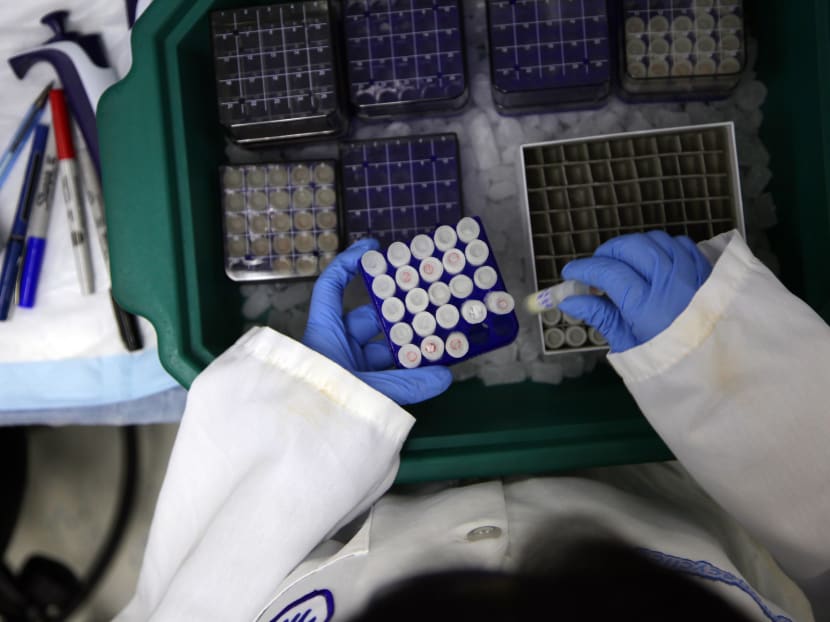What does it cost to create a cancer drug? Less than you’d think
UNITED STATES — What does it really cost to bring a drug to market?

A researcher at Pharmacyclics in Sunnyvale, California, which developed the cancer drug ibrutinib. The drug was sold for US$21 billion (S$28 billion). Photo: The New York Times
UNITED STATES — What does it really cost to bring a drug to market?
The question is central to the debate over rising healthcare costs and appropriate drug pricing. United States President Donald Trump campaigned on promises to lower the costs of drugs.
But numbers have been hard to come by. For years, the standard figure has been supplied by researchers at the Tufts Center for the Study of Drug Development: US$2.7 billion (S$3.6 billion) each, in 2017 dollars.
Yet a new study looking at 10 cancer medications, among the most expensive of new drugs, has arrived at a much lower figure: A median cost of US$757 million per drug. (Half cost less, and half more.)
Following approval, the 10 drugs together brought in US$67 billion, the researchers also concluded * a more than sevenfold return on investment. Nine out of 10 companies made money, but revenues varied enormously. One drug had not yet earned back its development costs.
The study, published Monday (Sept 11) in JAMA Internal Medicine, relied on company filings with the Securities and Exchange Commission to determine research and development costs.
"It seems like they have done a thoughtful and rigorous job," said Dr Aaron Kesselheim, director of the programme on regulation, therapeutics and the law at Brigham and Women's Hospital.
"It provides at least something of a reality check," he added.
The figures were met with swift criticism, however, by other experts and by representatives of the biotech industry, who said that the research did not adequately take into account the costs of the many experimental drugs that fail.
"It's a bit like saying it's a good business to go out and buy winning lottery tickets," Mr Daniel Seaton, a spokesman for the Biotechnology Innovation Organisation, said in an email.
Dr. Jerry Avorn, chief of the division of pharmacoepidemiology and pharmacoeconomics at Brigham and Women's Hospital, predicted that the paper would help fuel the debate over the prices of cancer drugs, which have soared so high "that we are getting into areas that are almost unimaginable economically", he said.
A leukemia treatment approved recently by the Food and Drug Administration, for example, will cost US$475,000 for a single treatment. It is the first of a wave of gene therapy treatments likely to carry staggering price tags.
"This is an important brick in the wall of this developing concern," he said.
Dr Vinay Prasad, an oncologist at Oregon Health and Science University, and Dr. Sham Mailankody, of Memorial Sloan Kettering Cancer Centre, arrived at their figures after reviewing data on 10 companies that brought a cancer drug to market in the past decade.
Since the companies also were developing other drugs that did not receive approval from the FDA, the researchers were able to include the companies' total spending on research and development, not just what they spent on the drugs that succeeded.
One striking example was ibrutinib, made by Pharmacyclics. It was approved in 2013 for patients with certain blood cancers who did not respond to conventional therapy.
Ibrutinib was the only drug out of four the company was developing to receive FDA approval. The company's research and development costs for their four drugs were US$388 million, the company's SEC filings indicated.
After it was approved, Janssen Biotech acquired the drug for US$21 billion. "That is a 50-fold difference between revenue post-approval and cost to develop," Dr Prasad said.
Accurate figures on drug development are difficult to find and often disputed. Although it is widely cited, the Tufts study also was fiercely criticised.
One objection was that the researchers, led by Mr Joseph A DiMasi, did not disclose the companies' data on development costs. The study involved 10 large companies, which were not named, and 106 investigational drugs, also not named.
But Mr DiMasi found the new study "irredeemably flawed at a fundamental level".
"The sample consists of relatively small companies that have gotten only one drug approved, with few other drugs of any type in development," he said. The result is "substantial selection bias", meaning that the estimates do not accurately reflect the industry as a whole.
Ninety-five per cent of cancer drugs that enter clinical trials fail, said Mr Seaton, of the biotech industry group. "The small handful of successful drugs * those looked at by this paper * must be profitable enough to finance all of the many failures this analysis leaves unexamined."
"When the rare event occurs that a company does win approval," he added, "the reward must be commensurate with taking on the multiple levels of risk not seen in any other industry if drug development is to remain economically viable for prospective investors."
Cancer drugs remain among the most expensive medications, with prices reaching the hundreds of thousands of dollars per patient.
Although the new study was small, its estimates are so much lower than previous figures, and the return on investment so great, that experts say they raise questions about whether soaring drug prices really are needed to encourage investment.
"That seems hard to swallow when they make seven times what they invested in the first four years," Dr Prasad said.
The new study has limitations, noted Dr Patricia Danzon, an economist at the University of Pennsylvania's Wharton School.
It involved just 10 small biotech companies whose cancer drugs were aimed at limited groups of patients with less common diseases.
For such drugs, the FDA often permits clinical trials to be very small and sometimes without control groups. Therefore development costs may have been lower for this group than for drugs that require longer and larger studies. THE NEW YORK TIMES






